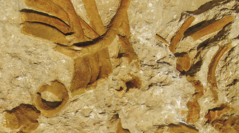

 Comptes Rendus Palevol
11 (6) - Pages 445-454
Comptes Rendus Palevol
11 (6) - Pages 445-454The application of Ground Penetrating Radar (GPR) in vertebrate palaeontology is very rare. We describe the discovery of an Early Pliocene sirenian skeleton detected by GPR in a locality near Grosseto (Tuscany, Italy). The specimen represents one of the most complete skeletons of Metaxytherium subapenninum (Mammalia: Sirenia) ever found in the Mediterranean area. Using a monostatic antenna of 200 MHz, this non-invasive technique allowed us to detect most of the bones of the skeleton (skull, mandible, vertebrae and ribs) revealed in a distinct zone reflecting the electromagnetic waves. Other bones were found in correspondence with some smaller reflective zones of high back-scattered energy. Each bone was located in a grid system to compare its position with the spatial distribution of reflective zones. We are confident that the positive outcomes experienced in this work will encourage the use of GPR for future field research in vertebrate palaeontology.
Sirenia, Pliocene, Ground Penetrating Radar